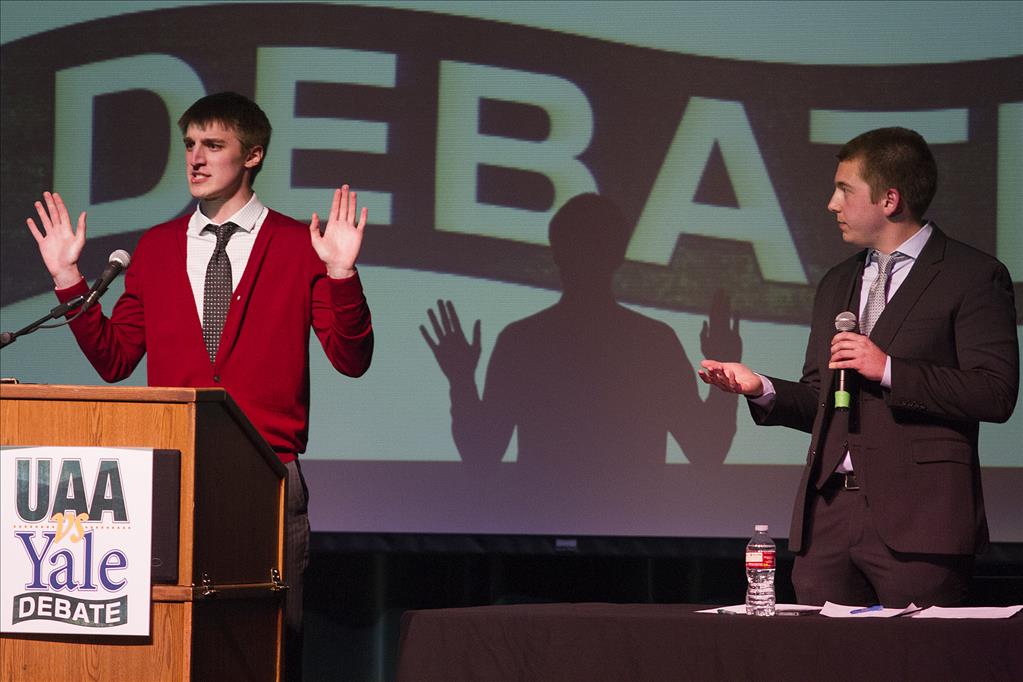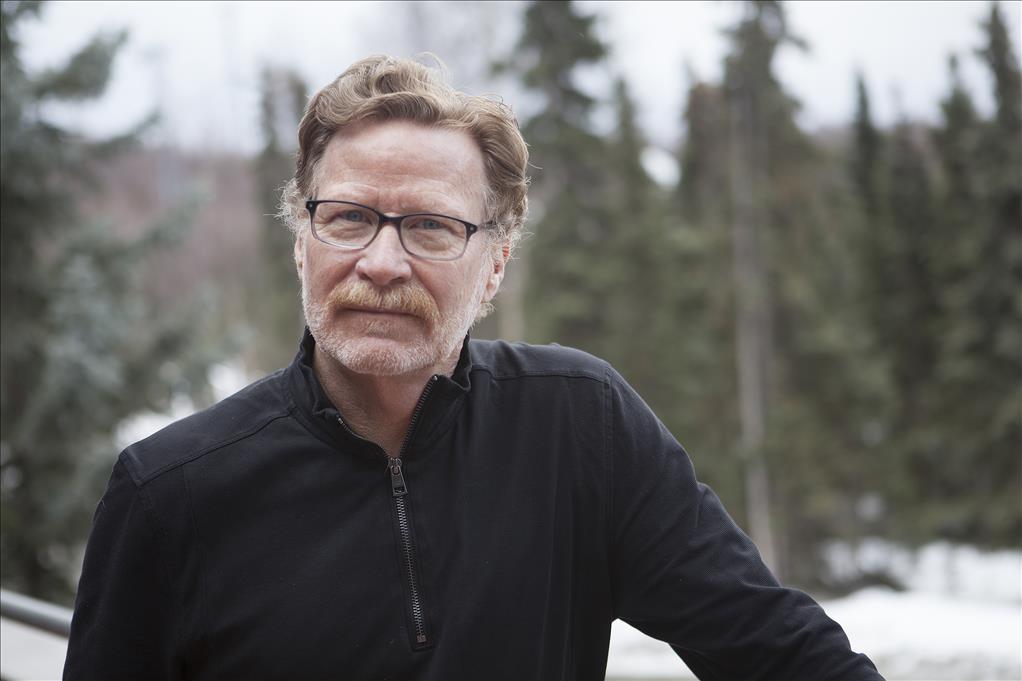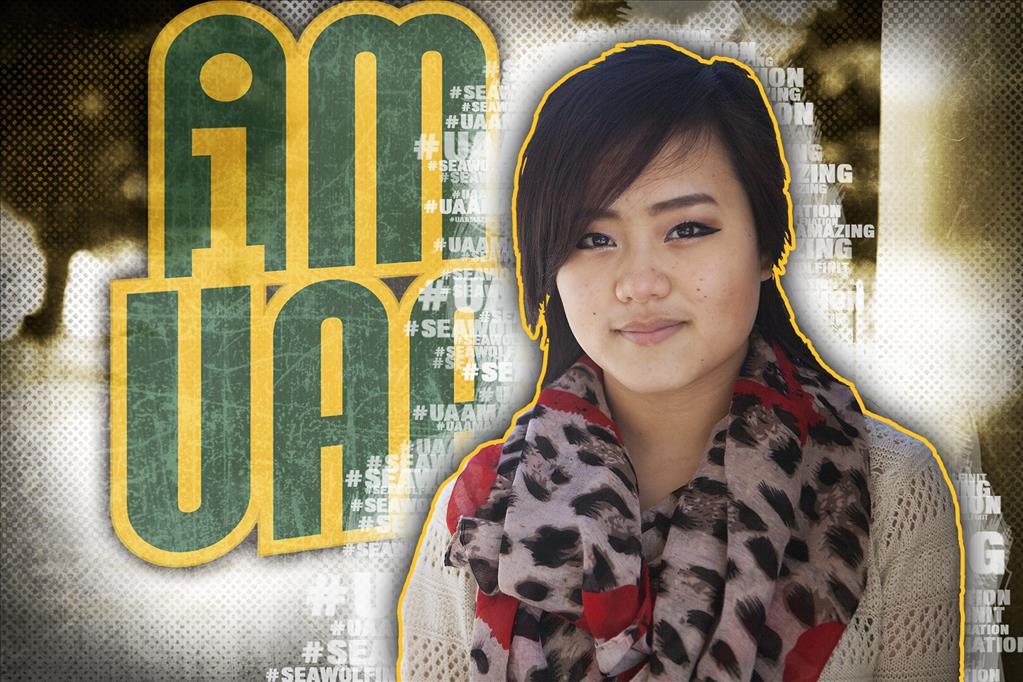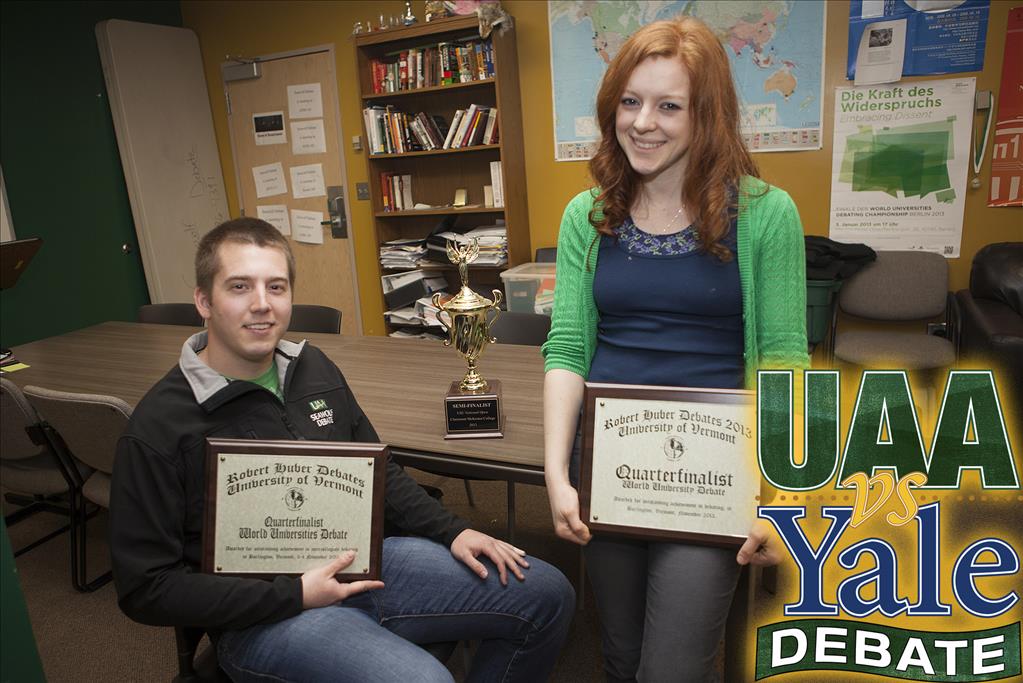Building a better Baja
by Tracy Kalytiak |
Zachary Garcia clicked a file on his computer screen, displaying a three-dimensional image of two mechanical gadgets.
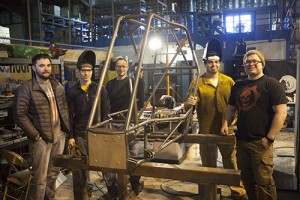
Devon Jones, Chris Burgess, Josh Tempel, Marcus Dueñez and Mariusz Sawicki pose with their Baja car frame at the UAA Design Studio. Photo by Philip Hall/University of Alaska Anchorage
"I've invested nearly 50 hours on this," the UAA engineering student said of the gadgets-virtual versions of high-carbon steel parts destined for a single-seat dune buggy-like off-road vehicle he and others on UAA's Baja team are creating. "This part holds the caliper on. I'm trying to figure out how to bolt it onto the bearing carrier, here, which involves complicated cuts. We can do it, but it takes time."
Every second counts, now, because the finished Baja vehicle must be ready April 3 to be shipped to El Paso, Texas, for the Baja SAE competition-one of three SAE International Collegiate Design Series competitions scheduled this spring in the U.S. The Baja showdown is scheduled for April 24-27 at the University of Texas at El Paso.
Stimulation of innovation
Teams from universities all over the world compete every year, testing their cars on outdoor tracks and challenges to see which Bajas are the fastest, strongest, most maneuverable, most innovative.
Josh Tempel and Josh Lazaro lead UAA's Baja team of mechanical and electrical engineering students. The other Baja team members are Sivisko Bernard, Chris Burgess, Taryn Byrd, Marcus Dueñez, Zachary Garcia, Devon Jones, Halvor Norris, Lowell Perry, Buck Polya, Mariusz Sawicki and Frazer Tee.
Corbin Rowe, UAA's machinist, isn't a member of the Baja team but he performs a crucial task: translating the students' SolidWorks renderings into steel and aluminum Baja parts using a manual mill, three-axis computer numeric control mill, lathe and other equipment housed in a machine shop a few steps away from the computer lab at UAA's University Lake Annex.
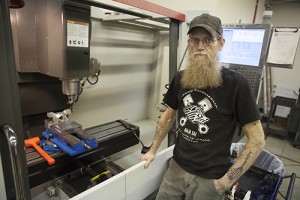
UAA machinist Corbin Rowe used a lathe and other equipment at University Lake Annex to machine parts UAA's Baja team designed. Photo by Philip Hall/University of Alaska Anchorage
"We've been lucky to have a machinist on UAA's staff here for us to ask questions," Zachary said. "That's been 50 percent of my learning experience. In school, you spend so much time on computers, in virtual reality or crunching numbers. But you have to make sure you designed a part that's possible to machine, that it will work in the real world."
UAA has raced four times at previous Baja SAE annual competitions. This year's UAA Baja team has a $25,000 budget, which includes the cost of materials, labor, shipping of the Baja car and transporting the team to El Paso. Briggs & Stratton donates 10-horsepower, four-cycle, air-cooled stock engines to every Baja participant. The team buys complicated components that would take too much time to custom make, such as brake calipers, which must be specially machined to withstand pressures within and forces passing through them, and the CVT (Continuously Variable Transmission), which uses a complex system of springs and weights to transfer the engine's output power to the transaxle.
"These things are heavily engineered by outside companies and it's in our best interest to focus on custom engineering what we think we can get done in the limited amount of time we have," Zachary said.
Local businesses have donated resources. Greer Tank and Welding Inc. used their water-jet cutting technology to cut out brackets and other Baja parts, for free. Superior Machine & Welding provided aluminum for the Baja team. "If we were to buy it, it could cost upwards of $200," Zachary said. Other sponsors include UAA School of Engineering, Alaska Native Science and Engineering Program (ANSEP), UAA Club Council, UAA Concert Board, BP, UAA Office of Undergraduate Research and Scholarship, Carlile Transportation Systems, AMC Engineers, Stinebaugh & Company, Larson Properties, Schafer Gearworks, Polaris, A2D Sledworks, Beadedstream, P3 Forge, Alaska Power Sports/Marita Sea & Ski, Action Sign & Graphics and Schlumberger Oilfield Services.
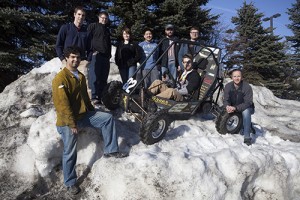
UAA's Baja Car team poses with the finished car on April 2, before preparing it for shipping the following day. Left to right, Marcus Dueñez, Chris Burgess, Josh Lazaro, Taryn Byrd, Frazer Tee, Devon Jones, Mariusz Sawicki, Josh Tempel and, in the car, Halvor Norris. Photo by Philip Hall/University of Alaska Anchorage
JoAnna Tomuro, college recruiting advisor for BP Alaska, says the Baja project directly aligns with BP's campus strategy for UAA.
"We like to support student professional associations or projects where students get to take their academic learning and put it into practical application," she wrote. "UAA's Baja Team is a great mix of engineering students who have done a fabulous job at representing UAA and Alaska in competition!"
Taking engineering to the track
Some of the Baja team members are completing frame assembly and other tasks at the UAA Engineering Design Studio, adjacent to University Center. The studio contains 4,300 feet of lab space and is equipped with drills, table saws, sanders, grinders, planers, tube and pipe benders, plasma cutters and welding machines.
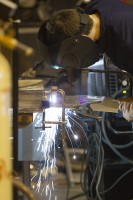
UAA engineering student Chris Burgess slices an aluminum sheet for UAA's Baja car. Photo by Philip Hall/University of Alaska Anchorage
"The biggest innovations," Josh Tempel said, "have been redesigning the suspension so it's tougher; the drivetrain, to have better gearing; and the frame, to be smaller. The biggest benefit of this project is understanding how engineering concepts apply to the real world."
Participants in the Baja project earn three independent-study credits. At the beginning of the fall semester, they split into teams that would, independently, design the car's frame, suspension and power train.
"It's been a learning process for all of us," Zachary said. "Building it has been very tricky. We designed with a team but during the build, the teams had to integrate together. We've had to manage time, prioritize parts that had to be built. Some parts just take a couple of minutes-brackets-but there are others that take time. You have to collaborate and make sure you don't have interference issues with other people's parts."
Zachary's rear caliper mount, for example, consumed more than 50 hours of design time because it had to fit over existing parts and withstand stresses the Baja will experience when it careens over steep hills on bumpy and tilting terrain, speeds around tight turns and hurtles through four hours of endurance laps.
"You take this guy and mount it to this bearing, which sits inside here," Zachary said, using his computer to move around the on-screen caliper mount and bearing carrier. "You can't change the size of this and we're trying to do this without breaching this inner diameter."
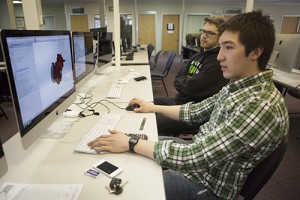
Halvor Norris, left, and Zachary Garcia work on SolidWorks designs for Baja car parts at the University Lake Annex. Photo by Philip Hall/University of Alaska Anchorage
Participating in the Baja competition cultivates skills students will use after graduation, on the job, said Dr. Jeff Hoffman, the team's faculty adviser.
"They're learning about money issues, timeline issues and serious logistics issues that are all about Alaska," Hoffman said. "Ninety percent of it is learning to work as a team. When there are disappointments, there's no finger-pointing. They put their heads together and come up with a solution. That will take them a long way in life."
Team members must use differential calculus and physics to analyze shear stress, impact forces, damping coefficiencies, tolerances and braking force while constructing and testing their Baja cars.
"I should finish the design today," Zachary said. "I'll probably be here pretty late. I've been putting in eight hours a day on top of school. This makes me appreciate the engineering it takes in the car I'm driving here."
Written by Tracy Kalytiak, UAA Office of University Advancement.
 "Building a better Baja" is licensed under a Creative Commons Attribution-NonCommercial 4.0 International License.
"Building a better Baja" is licensed under a Creative Commons Attribution-NonCommercial 4.0 International License.











